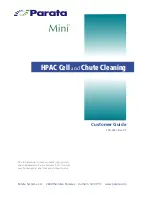
AERO.2000 User Guide July 2016
L16/1/18039
©2016 LINEAR ACOUSTIC INC. THE TELOS ALLIANCE. ALL RIGHTS RESERVED
Page 1
4
4
4
4
Introduction to AERO.2000
Introduction to AERO.2000
Introduction to AERO.2000
Introduction to AERO.2000
The Linear Acoustic AERO.2000 Audio Loudness Manager is a state-of-the-art, adaptive,
multiband, broadcast audio loudness controller with one or (optionally) two or three processing
instances, each of which can be specified in a 5.1+2+2, 2+2+2, or 2+2+2+2+2 configuration.
Each processing engine within the configuration can apply loudness control to the incoming
audio content. 5.1 surround processing engines (AMX5.1) can accept either discrete 5.1 audio
or upmix stereo content to 5.1 surround. The two 2-channel DRCs in an AMX5.1 engine can
function as independent stereo processors for other audio programs such as SAP or DVS, or
provide an Lo/Ro or Lt/Rt downmix of the 5.1 output (including automatic replacement of a
downmix in the absence of SAP audio) and, depending upon the specifics of the configuration,
insert local audio such as EAS or local emergency audio.
Professional audio metadata can be applied to the AERO.2000 to minimize processing and
control functions, such as upmixing. AERO.2000 protects itself against loss of incoming
metadata with reversion modes that apply user set reference loudness values. The resulting
audio is clean, consistent, and appropriately dynamic - perfect for transmission to consumers
via Dolby® Digital (AC-3), Dolby Digital Plus (E-AC-3), or any other format.
The AERO.2000’s features include:
•
Program configurations: any combination of three AMX5.1 (5.1+2+2), AMX2.0 (2+2+2),
or AMX5x2 (2+2+2+2+2) processing engines with support for local input on the last
stereo DRC of each instance.
•
HD/SD-SDI audio de-embedding and re-embedding for all eight embedded channel
pairs plus eight pairs of AES-3, unbalanced, I/O.
•
AEROMAX® multiband loudness processing which provides ITU-R BS.1770-3 and EBU
R128 compliant audio. AEROMAX includes wideband input AGC plus two additional
wideband AGC’s, two to five bands of multiband AGC and limiting, parametric EQ, look-
ahead final peak limiting, and selectable multiband source noise reduction.
•
ITU-R BS.1770-3 meters for LKFS or EBU R-128 measurement of each output program.
•
Selectable independent upmixers for main and local program sources, utilizing the
industry-standard UPMAX®II algorithm and AutoMAX™ detection and automatic
switching between stereo and discrete 5.1 sources.
















































